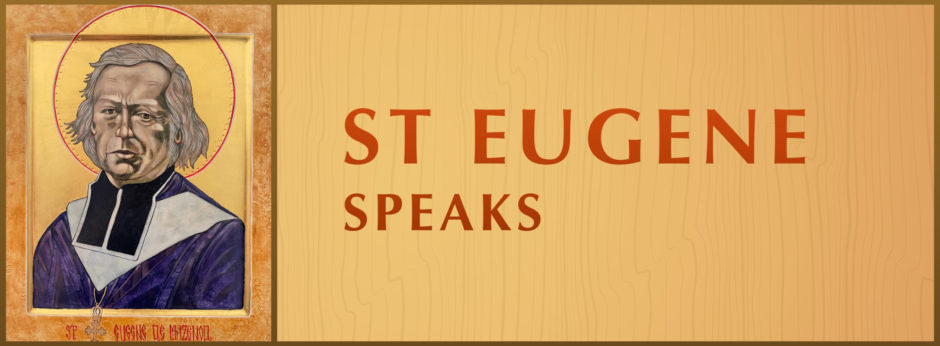The Oblate community in Marseilles seemed to have lost its sense of direction and the impression that Eugene gives is that everyone was too frightened to face the issues.
I have spent two days at Calvaire in spite of receiving overly-nervous advice that would have discouraged me from this course. Perhaps I would have paid more attention to it if I had not felt duty-bound in conscience to attend to everyone’s welfare.
Taking into consideration the factors that had disturbed the community’s well-being, Eugene, as the congregational major superior was conscious of his duty to intervene for the good of all.
Both the force of circumstances on the one hand and sickness, death and other factors on the other had conspired to disturb our fidelity.
Before holding the community meeting, he had met with each member privately to give him a fair hearing.
Before crossing the threshold, I heard each one in private.
Then he brought what he had heard to prayer:
In the presence of the Blessed Sacrament I pondered on the persons and matters concerned.
Only then did he call the community together – fully conscious that he was not acting by his own authority, but according to the authority of the Rule of Life, to which each Oblate had made a public commitment.
Then, with the Rule in my hand, I proceeded to re-establish the good order without which I would have had no title to enter the house.
It must be said, to everyone’s credit, that the matter needed only a half-hour conference in the course of which I put everything in its rightful place and from that moment everything has gone perfectly.
Letter to Hippolyte Courtès, 6 March 1831, EO VIII n 386
The method had worked: concern for the welfare of the community, gather the facts, reflect on them in prayer, and then using the light of the Rule and its authority, help the community to make its decisions.

Looking at how we can sometimes react before we respond. Especially in times of fear and instability that might come from within or from outside of our family, community, work place, etc. For these guys who have lived through the French Revolution, and who are living in ‘refined and enlightened’ chaos – the one answer Eugene could offer them was to remind them of their Rule of Life, that gift of the Holy Spirit to Eugene who then wrote it, had it approved by the Church and that remains today the community ‘rule for living’.
I think for a moment of the movie “Of Gods and Men” and how the Trappist Monks used a similar form to discern (not always a nice gentle flow) as they prayed, talked and made their decisions, each of them as to whether they would stay or would leave. I think of AA’s 12 Steps, the Bible, and other ‘rules of life’; all there for us to return to. The Rule of Life, the Constitutions and Rules with the ‘framework’, the heart and then the ‘how to’.
I am again reminded of the “Illuminated Crowd” sculpture. In the front – a large group of people responding to a great light or event, as they stand close together, joined somehow as they seem experience joy, awe, and wonder. And then the changes that occur as you move back through the crowd, with the people separating themselves from each other in in fear and then further back where arrogance, anger and violence are finding life. Chaos seems to become the norm as they seem to lose their humanity.
I have recently been experiencing fear in my own life – not so dire as what the Trappist Monks went through, or what was happening in Marseilles in 1831 with the Oblate community, but it sometimes the smallest cracks in a sculpture that cause the deepest damage. For me an imposed change brought fear and hurt. My reactions were not stellar at first, but after ‘consulting’ (which did not exclude God at all) and returning to my own values and the 12 Steps, the Bible and Constitutions and Rules, I looked at how I would ‘respond’ and be.
Looking at Eugene, and the Oblates and the model they have shared with me I realise, recognize not their responsibility, or the responsibility of the one who began the change – but also my own responsibility to choose good or bad, life or death. Do I choose the death that was depicted at the back end of the ‘Illuminated Crowd’ sculpture or do I choose to find a way to join the life with those at the front of the sculpture?
Thanks Frank and Eleanor for sharing good insight today. God bless. Kirk